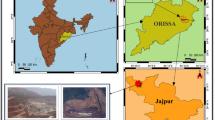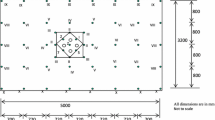Abstract
Excavation of coal, overburden, and mineral deposits by blasting is dominant over the globe to date, although there are certain undesirable effects of blasting which need to be controlled. Blast-induced vibration is one of the major concerns for blast designers as it may lead to structural damage. The empirical method for prediction of blast-induced vibration has been adopted by many researchers in the form of predictor equations. Predictor equations are site specific and indirectly related to physicomechanical and geological properties of rock mass as blast-induced ground vibration is a function of various controllable and uncontrollable parameters. Rock parameters for blasting face and propagation media for blast vibration waves are uncontrollable parameters, whereas blast design parameters like hole diameter, hole depth, column length of explosive charge, total number of blast holes, burden, spacing, explosive charge per delay, total explosive charge in a blasting round, and initiation system are controllable parameters. Optimization of blast design parameters is based on site condition and availability of equipment. Most of the smaller mines have predesigned blasting parameters except explosive charge per delay, total explosive charge, and distance of blast face from surface structures. However, larger opencast mines have variations in blast design parameters for different benches based on strata condition: Multivariate predictor equation is necessary in such case. This paper deals with a case study to establish multivariate predictor equation for Moher and Moher Amlohri Extension opencast mine of India. The multivariate statistical regression approach to establish linear and logarithmic scale relation between variables to predict peak particle velocity (PPV) has been used for this purpose. Blast design has been proposed based on established multivariate regression equation to optimize blast design parameters keeping PPV within legislative limits.








Similar content being viewed by others
References
http://www.statsdirect.com/help/basics/p_values.htm. Accessed 28th July 2017
https://en.wikipedia.org/wiki/P-value. Accessed 28th July 2017
Ambraseys NR, Hendron AJ (1968) Dynamic behaviour of rock masses: rock mechanics in engineering practices. Wiley, London
Athanasopoulous GA, Pelekis PC (2000) Ground vibrations from sheetpile driving in urban environment: measurements, analysis and effects on buildings and occupants. Soil Dyn Earthq Eng 19(5):371–387
Blair BE, Duvall WI (1954) Evaluation of gauges for measuring displacement, velocity and acceleration of seismic pulses. USBM RT 5073
Cardu M, Dompieri M, Seccatore J (2012) Complexity analysis of blast-induced vibrations in underground mining: a case study. Min Sci Technol 22(1):125–131
Cardu M, Mucci A, Uyar G (2015) Investigating the effects of bench geometry and delay times on the blast induced vibrations in an open-pit quarry. GEAM 1:45–56
Central Mining Research Institute (CMRI) (1993) Vibration standards, Dhanbad
Dauetas AA, Denisyuk II, Kuzmenko AA, Vorobev VD (1993) Seismic effects of blasting in rock. Vol. 103. CRC Press
Directorate General of Mines Safety (1997) Damage of structures due to blast induced ground vibrations in the mining area. DGMS (Tech) (S & T) circular No. 7 of 1997 dated 29th August 1997, pp 09–12
Dowding CH (1971) Response of buildings to ground vibrations resulting from construction blasting. Doctoral dissertation, University of Illinois at Urbana-Champaign
Duvall WI, Johnson CF, Meyer AVC (1963) Vibrations from blasting at Iowa limestone quarries. USBM RI 6270
Duvall WI, Fogelson DE (1962) Review of criteria for estimating damage to residences from blasting vibrations. US Department of the Interior, Bureau of Mines
Duvall WI, Petkof B (1959) Spherical propagation of explosion generated strain pulses in rock. USBM RI 5483
Ghosh A, Daemen JK (1983) A simple new blast vibration predictor. Proc. 24th US Symp. Rock Mechanics, Texas, USA, pp 151–161
Giraudi A, Cardu M, Kecojevic V (2009) An assessment of blasting vibrations: a case study on quarry operation. Am J Environ Sci 5(4):468–474
IS 6922 (1973) Criteria for safety and design of structures subject to underground blast. New Delhi, India: Bureau of Indian Standards (BIS)
Jimeno CL, Jimeno EL, Carcedo FJA (1995) Drilling and blasting of rocks. A. A. Balkema, Rotterdam, p 391
Kahriman A (2001) Prediction of particle velocity caused by blasting for an infrastructure excavation covering granite bedrock. Miner Resour Eng 10(02):205–218
Kahriman A (2002) Analysis of ground vibrations caused by bench blasting at can open-pit lignite mine in Turkey. Environ Geol 41(6):653–661
Kumar R, Choudhury D, Bhargava K (2012) Response of foundations subjected to blast loadings: state of the art review. Disaster Advances 5(1):54–63
Kuzu C (2008) The importance of site-specific characters in prediction models for blast-induced ground vibrations. Soil Dyn Earthq Eng 28(5):405–414
Langefors U, Kihlstrom B (1963) The modern technique of rock blasting. Wiley, New York
Monjezi M, Ahmadi M, Sheikhan M, Bahrami A, Salimi AR (2010) Predicting blast- induced ground vibration using various types of neural networks. Soil Dyn Earthq Eng 30(11):1233–1236
Monzeji M, Ghafurikalajahi M, Bahrami A (2011) Prediction of blast-induced ground vibration using artificial neural networks. Tunn Undergr Space Technol 26(1):46–50
Moris G (1950) Vibration due to blasting and their effects on building structure. The Engineer, London, pp 394–395
Pal RP (1993) Putting ground vibration predictors into practice. Colliery Guardian 241(2):63–67
Pal Roy P (1991) Vibration control in an opencast mine based on improved blast vibration predictors. Min Sci Tec 12(2):157–165
Rai R, Singh TN (2004) A new predictor for ground vibration prediction and its comparison with other predictors. Ind J Eng Mat Sci 11:178–184
Rai R, Shrivastva BK, Singh TN (2005) Prediction of maximum safe charge per delay in surface mining. Trans Ins Min Met, Section A: Mining Technology 114(4):227–231
Singh PK, Roy MP (2010) Damage to surface structures due to blast vibration. Int J Rock Mech Min Sci 47(6):949–961
Acknowledgements
The authors express their thanks and gratitude to Mine Management of Moher and Moher Amlohri Opencast Project, and M/s Sasan Power Limited for providing necessary facilities during field investigations. The input of the departmental colleagues of Rock Excavation Engineering Division, CSIR-CIMFR, Dhanbad, is thankfully acknowledged.
Author information
Authors and Affiliations
Corresponding author
Rights and permissions
About this article
Cite this article
Himanshu, V.K., Roy, M.P., Mishra, A.K. et al. Multivariate statistical analysis approach for prediction of blast-induced ground vibration. Arab J Geosci 11, 460 (2018). https://doi.org/10.1007/s12517-018-3796-8
Received:
Accepted:
Published:
DOI: https://doi.org/10.1007/s12517-018-3796-8




